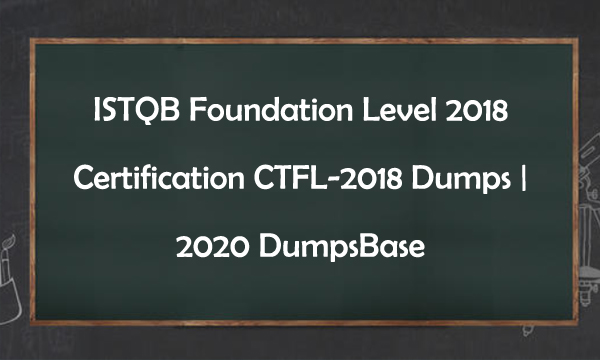ISTQB Foundation Level 2018 Certification CTFL-2018 Dumps | 2020 DumpsBase
Become a ISTQB Certified Tester Foundation Level 2018 certified with DumpsBase new ISTQB Foundation Level 2018 Certification CTFL-2018 Dumps today. We have released new CTFL-2018 dumps questions on February 14, 2020, which contains 40 practice questions and answers to help you complete the ISTQB® Certified Tester - Foundation Level certification. It is highly recommended to take DumpsBase CTFL-2018 dumps questions in pdf file and free software for the good preparation.

Who can take 2018 Foundation Level CTFL-2018 exam?
We know that Foundation Level is core to the ISTQB® Certified Tester Scheme providing essential understanding and knowledge to anyone involved in testing. New Certified Tester Foundation Level 2018 (CTFL) Syllabus was released in 2018. The release consists of the ISTQB® Foundation Level 2018 syllabus, an Overview document, Accreditation guidelines, Glossary items and terms, Release Notes including traceability on Learning Objectives level from the 2011 to the 2018 syllabus.
Based on the introduction, CTFL-2018 ISTQB Certified Tester Foundation Level 2018 exam is suitable for anyone who needs to demonstrate practical knowledge of the fundamental concepts of software testing including people in roles such as testers, test analysts, test engineers, test consultants, test managers, user acceptance testers and software developers.
Also, it is appropriate for individuals who need a basic understanding of software testing including project managers, quality managers, software development managers, business analysts, IT directors and management consultants.
How many real questions in actual CTFL-2018 exam?
Real CTFL-2018 ISTQB Certified Tester Foundation Level 2018 exam has 40 multiple-choice questions. According to the requirement, CTFL-2018 real exam is needed to complete in 60 minutes with a pass mark grade of 65%. Participants that take the exam not in their spoken language, will receive additional 25% time, for a total of 75 minutes.

Additionally, we have collected the CTFL-2018 2018 Foundation Level Learning objectives as follows:
Chapter 1 Fundamentals of Testing
Chapter 2 Testing Throughout the Software Development Lifecycle
Chapter 3 Static Testing
Chapter 4 Test Techniques
Chapter 5 Test Management
Chapter 6 Tool Support for Testing
How to make sure DumpsBase CTFL-2018 exam dumps is valid in 2020?
ISTQB Foundation Level 2018 Certification CTFL-2018 Dumps from DumpsBase have been verified that the practice questions and answers are valid for good preparation. How to make sure? You can read CTFL-2018 free dumps online:
Which of the following BEST describes a Test Case?
A. A statement about “what to test” in terms of measurable coverage criteria from analysis of the test basis.
B. A set of preconditions, inputs, actions, expected results and postconditions developed based on test conditions.
C. A description of the test objectives to be achieved and the means and the schedule for achieving them.
D. A source to determine expected results to compare with the actual result of the system under test.
Answer: B
Testing and Debugging are key activities in the software development lifecycle.
Which of the following are DEBUGGING activities?
a) Designing tests to find failures.
b) Locating the cause of failures.
c) Analysing and fixing the defects.
d) Executing tests to show failures.
A. a and d.
B. a and b.
C. b and c.
D. c and d.
Answer: B
Which of the following options describe the chain of events in the correct sequence?
A. Error, fault, failure.
B. Fault, bug, mistake.
C. Mistake, failure, fault.
D. Failure, bug, error.
Answer: A
During the development of a software change for a system, the developer makes a mistake in his work, which leads to a fault in the code. Unfortunately, the fault is not found by software testing and is released into live.
What is the DEFINITE consequence of this mistake?
A. The system will fail, causing a defect.
B. If the defect is executed, the system may fail.
C. Loss of money, time, or business reputation.
D. Contractual requirements have not been met by testing.
Answer: B
Which of the following options BEST explains the pesticide paradox principle of testing?
A. If we do not regularly review and revise our tests, we’ll stop finding defects.
B. Repeatedly running a set of tests will ensure that a system is defect free.
C. Defects are, paradoxically, often contained in a small number of modules.
D. Testing, like spraying pesticide, is an effective bug/defect removal activity.
Answer: C
During which stage of the fundamental test process is the testability of requirements evaluated?
A. Test Execution.
B. Test Planning.
C. Test Design.
D. Test Analysis.
Answer: D
Which of the following would achieve the HIGHEST level of testing independence for a project’s system test level?
A. Training developers to design good tests for the test team to execute.
B. Outsourcing test design and execution to a different company.
C. Having the company’s independent test team design and execute the tests.
D. Minimising contact between testers and developers during test design to avoid bias.
Answer: A
Which ONE of the following is the BEST way to take advantage of the different mindsets of testers and developers?
A. Insist on independent testing at all stages in the lifecycle.
B. Have all developers undergo ISTQB training.
C. Keep developers and testers in separate teams.
D. Bring the two mindsets together.
Answer: D
